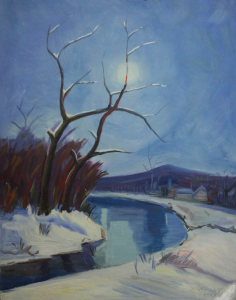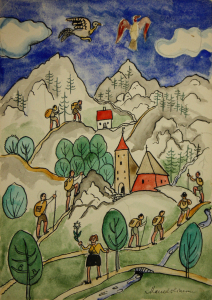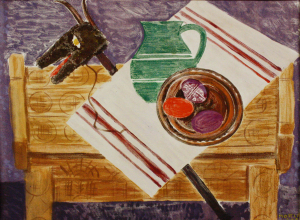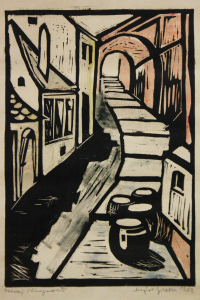DISCOVER DISCOUNTS I INVEST IN ART I OFFER GIFTS WITH PERENNIAL VALUE
pastel, cardboard
42 x 28 cm
unsigned
good state of conservation
We know that this work was done together with a relevant "work - pair" (technique, size, style), namely "Wife of the military doctor", which bears the signature and date of realization, signed and dated lower right: C. Baba / 40.
The portrait was a recurring subject in the artist's lifelong work, which he considered the "pregnant element" in painting, and the "designs" according to the model were never too many, Baba said: "the hand must never rest." His hand training drawings, as expressed above, included a wide range of techniques, starting with pencil, ink, stain, watercolor, tempera and ending with the more complex valences of the pastel.
Also from the artist's diary, we find out that although he was settled in Iasi since 1934, between 1939 and 1940, he lived the "refugee disasters" even in Transylvania, being involved in the decoration of the Orthodox chapel of the Municipal Cemetery, in Oradea Mare. It is also the time of 1940 when he begins to make his debut at the Official Salons.
From a stylistic point of view, the "Portrait of the Military Doctor" illustrates a beginning of the journey through the quasi-academic picture of a figure rendered in front, in three quarters, with realistic accents and also through the practice, also later abandoned, of a drawing with a grammar. clear linear, proper only to this stage of the artist's creation.
A native colorist, in the Venetian descent of Tiziano Vecellio or later of Francisco Goya, Baba will prefer between graphic techniques, pastel technique, advocating the pictoriality of the color spot, its ability to render the finesse, spontaneity, transience of a vision. It was for Baba, the beginning of a whole decade of technical turmoil, in an attempt to overcome the freezing of pictorial language in conventional neo-academic formulas. This realism of the 1940s, anchored in the past of classical academic art, to which Baba will never return, illustrates a short stop on the way to the later consecrated pictorial solution, of portraits created in the theatrical or museum atmosphere (initially critically unappreciated), of a colorist. a budding expressionist and an attentive researcher, accredited by the extensive study throughout his life and plastic works, of a fine connoisseur of human psychology.
BABA, Corneliu (1906, Craiova - 1997, Bucharest, Romania)
Artistic education: Iasi Academy of Fine Arts (1934-1938), professor Nicolae TONITZA. He studied further with Ion BĂLĂNESCU. Bucharest Faculty of Letters, (1926-1930).
The artist has organized 13 personal exhibitions in the country and abroad (New York, Brussels, Vienna, Berlin, Moscow, Chisinau, St. Petersburg, Budapest, Sofia) and has benefited from 2 retrospective exhibitions (Bucharest, 2003, 2006). Between 1931-1956 the artist participated in 14 group exhibitions and national salons, and in 1954 and 1956 he represented Romania at the Venice Biennale. He was awarded 3 national prizes (1942, 1953, 1962).
Delivery date: 2 zile lucrătoare
Product Code:
212-3915-1369
Do you need help?
0040-773782689
/
0040-745525288
- Characteristics
- Reviews (0)
Certificate de AUTENTICITATE: Certificate de AUTENTICITATE
If you want to express your opinion about this product you can add a review.
write a review

![Corneliu BABA, Portrait of a Military Doctor, 1940 [1] Corneliu BABA, Portrait of a Military Doctor, 1940 [1]](https://gomagcdn.ro/domains/depozituldearta.ro/files/product/large/img_1319-213-833797146932.jpg)
![Corneliu BABA, Portrait of a Military Doctor, 1940 [2] Corneliu BABA, Portrait of a Military Doctor, 1940 [2]](https://gomagcdn.ro/domains/depozituldearta.ro/files/product/large/img_1312-213-322441096606.jpg)
![Corneliu BABA, Portrait of a Military Doctor, 1940 [3] Corneliu BABA, Portrait of a Military Doctor, 1940 [3]](https://gomagcdn.ro/domains/depozituldearta.ro/files/product/large/img_1308-213-551561193611.jpg)
![Corneliu BABA, Portrait of a Military Doctor, 1940 [4] Corneliu BABA, Portrait of a Military Doctor, 1940 [4]](https://gomagcdn.ro/domains/depozituldearta.ro/files/product/large/img_1306-213-819195045946.jpg)
![Corneliu BABA, Portrait of a Military Doctor, 1940 [5] Corneliu BABA, Portrait of a Military Doctor, 1940 [5]](https://gomagcdn.ro/domains/depozituldearta.ro/files/product/large/img_1322-213-766375912122.jpg)
![Corneliu BABA, Portrait of a Military Doctor, 1940 [0] Corneliu BABA, Portrait of a Military Doctor, 1940 [0]](https://gomagcdn.ro/domains/depozituldearta.ro/files/product/medium/img_1319-213-833797146932.jpg)
![Corneliu BABA, Portrait of a Military Doctor, 1940 [1] Corneliu BABA, Portrait of a Military Doctor, 1940 [1]](https://gomagcdn.ro/domains/depozituldearta.ro/files/product/medium/img_1312-213-322441096606.jpg)
![Corneliu BABA, Portrait of a Military Doctor, 1940 [2] Corneliu BABA, Portrait of a Military Doctor, 1940 [2]](https://gomagcdn.ro/domains/depozituldearta.ro/files/product/medium/img_1308-213-551561193611.jpg)
![Corneliu BABA, Portrait of a Military Doctor, 1940 [3] Corneliu BABA, Portrait of a Military Doctor, 1940 [3]](https://gomagcdn.ro/domains/depozituldearta.ro/files/product/medium/img_1306-213-819195045946.jpg)
![Corneliu BABA, Portrait of a Military Doctor, 1940 [4] Corneliu BABA, Portrait of a Military Doctor, 1940 [4]](https://gomagcdn.ro/domains/depozituldearta.ro/files/product/medium/img_1322-213-766375912122.jpg)














